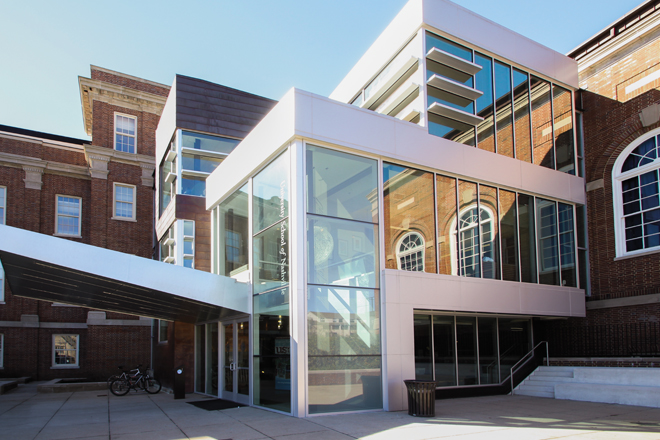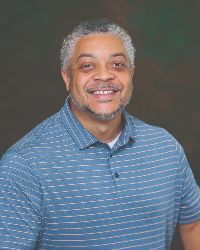
Interview by Cecily Garber
Photo above shows additions to the original building at USN.
Roderick White is the director of the Office of Diversity and Community Life at the University School of Nashville, a K–12 day school with 1,068 students.

Director of the Office of Diversity and University Life
How did the Office of Diversity and Community Life at the University School of Nashville and your position as its director come to be?
The office has been around for more than 20 years. I don’t know what USN would look like without this position. Part of our mission is to model the makeup of what metropolitan Nashville looks like. Of course we are striving to model the best educational practices and to lead through innovation, but we are also modeling our community at large.
We want our students to excel not only in academics, but also in life, as community advocates and leaders of the next generation in our society. Social and emotional learning are just as important as the academic classroom. As educators we are asking, what kind of impact will our graduates have on society at large? The world is made up of different people. It’s very hard to communicate if I don’t know who you are or who I am. We are trying to create a safe space where people feel comfortable discussing who they are.
What are your day-to-day responsibilities?
I am one of a few administrators who have duties across the school. Every day I work with students from kindergarten to fifth grade to 12th grade. A lot of the work is making sure that everyone here is not only reflective of the diversity we have, but feels included in the conversation. Diversity is just a visual. We want to model that, but more importantly we want to be inclusive. When students, families and faculty decide to join us here on campus, we don’t want to ask them to be something that they’re not, to hide who they are. Our community is enriched when everyone brings their full selves.
When students, families and faculty decide to join us here on campus, we don’t want to ask them to be something that they’re not, to hide who they are.
I have an office, but I’m rarely in it. A typical day may start in the lower school in second grade, where the students are doing a unit on the origins of Nashville, and how race played a part in the history of the city. In middle school we might have round table discussions on racial identity, what does “race” mean, and how these are human constructs. In high school psychology class, we might talk about the impact of social media on unconscious biases. I try to have a common theme across divisions. This year our school theme is “identity.” Each month, we will concentrate on a different identifier. We started the year with age, and this month is religion.
I joke that my office is just the place where I put my pencils, but I do spend time there. It’s a place where people feel safe to have conversations they don’t want to have in front of a large group — tough conversations that take a little more emotion, are more taxing. In all our work, we want to enable students to take the lead. While I am always available for students and faculty, I don’t want to push my resources on them; I want them to reach out.
Can you give some examples of student-led programs?
Students created a group called ALBANIE, which stands for Asian Latino Biracial African American Native American International European. They wanted to make sure they’re being totally inclusive of everyone in the world. They meet weekly to discuss current topics and events. Students lead the conversation and speakers present. Faculty attend and sometimes we speak, if kids allow us.
Another group is IDA, the Intersectionality and Diversity Alliance, which is for our upper-class students. It’s a conglomeration of other groups like the Gay Straight Alliance, Feminism Club, Hispanic Heritage Club, International Club — it’s a large group meeting. They put on a yearly event called SPARK, Speaking Plainly About Real Change, in which they bring in speakers, have music, host a roundtable discussion. We have a lot of acronyms [laughs].
We have an African American student affinity group that meets biweekly, and we’re launching Asian American and Latino groups this year, as well as parent groups. I’m very excited about it. The groups give everyone the opportunity to have their voice heard. It shows the school is investing in them; it’s not just them investing in the school. These events are held on weekends and after school hours, which is asking a lot of students. It must be important to them.
Who else on campus is involved in diversity programs?
Every division and every department at our school owns this work. It hasn’t been placed just on my shoulders. It would be extremely difficult if I had to do all this by myself, and I’m blessed to have so many people that are excited to do this work.
It would be extremely difficult if I had to do all this by myself, and I’m blessed to have so many people that are excited to do this work.
At our division meetings (the lower, middle and high school faculty meetings), we discuss how teachers would handle different conversations with a student, for example. We also look at our curriculum on a regular basis to make sure it’s inclusive. I work with a number of committees. One focuses on hiring educators of color, another on cultural competencies, for example. All this is ongoing.
We’re also very collaborative with other schools in our area, from Nashville, Memphis, Chattanooga. I probably speak with them on a monthly basis about best practices and what’s working at our schools. Last year USN hosted an on-campus career fair for educators of color interested in independent schools. Twenty schools from across the state attended, and we’re holding it again because the interest was so high.
What are some best practices for attracting educators of color?
Attracting educators of color to an independent school can be challenging, especially when the majority of them did not attend independent schools themselves. The school must have very intentional conversations and goals. It’s also important to actively speak with potential educators before they enter the workforce. Our faculty members regularly visit local colleges and universities to engage with education majors while they are still in school — Vanderbilt, Tennessee State University, Belmont, Fisk, David Lipscomb and others.
Does the work on diversity and community life impact enrollment at USN?
What we can do is see how our students talk to other people in the community about USN and how people want to be a part of the community. Nine times out of 10 what brought prospective students and families here is diversity.
The [results of the] work we’re doing is not something we can put on a spreadsheet. What we can do is see how our students talk to other people in the community about USN and how people want to be a part of the community. Nine times out of 10 what brought prospective students and families here is diversity. They say that. Our student body is 36 percent students of color. Twenty percent of those are international students, who are coming from 50 different countries. We also have a committee that goes to under-represented communities in Nashville to let them know we’re here for them.
We do an amazing job with academics — don’t get me wrong — but people come from far and wide because they want their children to have diversity and inclusion being a part of everyday living. The commitment to diversity has been part of the school community since its inception, and it shows. When you tour the school you can see yourself and family reflected in the student body. We dedicate time and money to these programs. It’s really our culture.
Does financial aid play a role in USN’s commitment to diversity?
Financial aid is a part of our school business model because we don’t want finances to be an encumbrance for students to attend. We’ve dedicated funds to it because it’s part of making the school what it is, just like the buses that get students to school, and the desks in the classrooms. It is important to remember that financial aid does not equal diversity and inclusion; the aid supports our students and families once they decide to join and enrich our school community.


